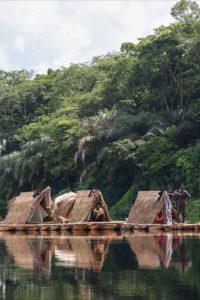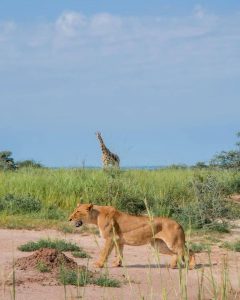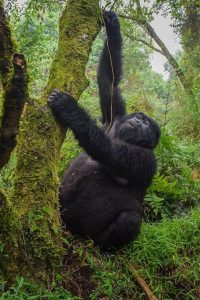What to do and see in Kibale National Park
In Uganda’s western region, in the East African Rift Valley, next to the Ndali Kasenda crater, sits Kibale National Park. Which is 1,100 meters above sea level and 1,590 meters above sea level. Because of its high biodiversity, Kibale National Park was first designated as a forest reserve in 1932. In the 1990s, it was transformed into a game park. The park has emerged as Uganda’s and much of East Africa’s primate capital. What to do and see in Kibale National Park
Additionally, the park features lowland and montane forests that are home to endangered species such as Entandrophragma, Cordia millenii, and Lovoa swynnertonnii. The dense ferns, herbs, and grasses are made possible by the more than 1700 mm of rainfall that the tall trees, which average 55 m in height, provide each year.
How to Get to Kibale National Park
Compared to Bwindi or Mgahinga, which are in Uganda’s southwest, Kibale National Park is much easier to get to. Driving past Mubende and Fort Portal on a direct road from Kampala takes five to six hours. The Kamwenge or Mbarara road is an option for those traveling from the southern part of the park. Taking a chartered flight from Kajjansi along the Entebbe-Kampala highway to either Ndali or Fort Portal, and then driving to the park, is a far more practical and expedient method of getting to the park.
Things to Do at Kibale Forest National Park
For a primate trip, Kibale National Park is perhaps the greatest destination. The park boasts more primates than any other in East Africa, even though it does not have gorillas. A unique species, chimpanzees share more than 95% of their DNA with humans, making them endangered. About 5,000 chimpanzees have been documented in Kibale, home of the largest chimpanzee clans in East Africa. Compared to Kibale Forest, the odds of spotting chimpanzees are far lower in other East African parks. What to do and see in Kibale National Park
Observing birds
Uganda is regarded as one of Africa’s top three destinations for birdwatching. With more than 374 bird species, Kibale’s 180-kilometer rain forest is a birder’s heaven. Birdwatchers can see the Abyssinian Ground Thrust, African Grey Parrot, Black Bee Eater. Black Capped Apalis, Black Eared Ground Thrust, Blue headed sunbird, Brown Chested Alethe. Brown Illadopis, Collared Apalis, Crowned Eagle, Dusky Crimsonwing, Little Green Bul. Purple breasted Sunbird, Red Chested Owlet, Red Faced Woodland Warbler, Scaly breasted Illadopsis, the African Pitta, Western Nicator, White naped Pigeon. Yellow Rumped Tinkerbird, yellow spotted Nicator and Blue Breasted Kingfisher
Uganda’s Kibale National Park, other fauna
In addition to monkeys and birds, Kibale National Park is home to more than 20 different kinds of reptiles. Over 200 butterfly species, 27 frog species, and 14 snake species. Bats, bush pigs, giant forest hogs, elephants, forest buffaloes, leopards, hippopotamuses, bushbuck antelopes, red/blue duikers, sitatungas semi-aquatic antelopes, warthogs, African golden cats, mongooses, and the occasionally spotted hyenas are among the nearly 70 mammal species found in Kibale National Park.
Locals
There are many worthwhile activities for individuals who want to experience the local way of life. Anyone looking for a cultural experience should make a trip to see the Batoro, the dominating tribe that lives close to the park. The Omukama is the king of the noble Batoro people, who have a rich history, culture, and tradition. The Bakiga are another tribe you may want to see. The Bakiga are an industrious people that depend on growing a variety of indigenous goods for sustenance, especially the well-known Matoke (bananas).
Hikes and nature walks
Discovering and admiring the park’s and the surrounding landscapes’ immense biodiversity, which includes touring the Amabere caverns, is best done by taking a stroll through the expansive woodland. Safaris in Kibale National ParkSebitoli or Kanyanchu can serve as the beginning sites. You will be able to enjoy the whole display of tropical woods, meadows, wetlands, and rivers no matter where you begin your tour in the park. A stroll through the villages of Nyaibanda, Nyakalongo, and Kikoni would be ideal for anyone who wants to see how the locals live their lives and tend to the gardens. To see nocturnal creatures like pottos, bush babies, and other uncommon birds that are only active at night.
Wetlands and bird sanctuary in Bigodi
To explore the park’s Bigodi Wetlands Sanctuary, a unique nature walk can be planned. With thousands of tourists each year, this is one of the greatest locations in East Africa for seeing birds and primates. Over 310 different bird species can be seen on a three-hour trip in the Bigodi marsh. You should anticipate seeing at least five distinct types of primates as you stroll among the palm trees and other flora.
Accommodation in Kibale National Park
Spending a safari vacation that ends with you retiring to a cozy room amid stunning scenery and pure air is something to remember. Wide ranges of lodging options are available in Kibale National Park. While on safari in Uganda, you can choose from upscale, mid-range, and low-cost lodging options. Within the park’s Kanyanchu, Ndali, Nkingo and Bigodi regions are the majority of the lodges and motels.




